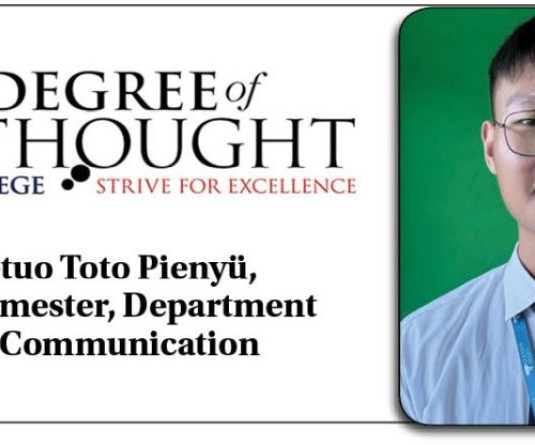
KC Gabriela, Assistant Professor, Tetso College, Department of Mass Communication
Education is the cornerstone for social economic development. Globalisation and technological changes have created a new global economy that is “powered by technology, fueled by information and driven by knowledge.” And this has obviously affected the educational institutions as education and institutions try to incorporate the facilities of technology to improve learning methods, to enhance educational capacity. If the world has been slowly trying to integrate the usage of technology in education, the pandemic came and expedited the process. From simple emails for assignments to full-fledged apps for classroom learning, the pedagogy in teaching and learning has come a long way. India is moving towards a digitally empowered society and knowledge economy with Digital India campaign that has been at the centre of the current government’s agenda. While the country maybe aiming for a fully digitalised future, there are pockets of geographies which might be ailing from the basic rights of uninterrupted electricity, let alone the access to technology- internet and technological devices.
Studies in ICTs have shown high concern that it might widen the gap between the rich and the poor, the haves and the have nots, between different groups in the country. The marginalisation became even more evident when the pandemic hit the world. The virus came and shut down the entire world; workplaces, stores and all non- essential businesses, schools and colleges, everything came to a halt while governments of every country were trying to figure out how to adapt in this new social distancing world. Students and educational institutions had to come up with new ways to keep up with their studies. ICT was now in the forefront more than ever before Classrooms were switched to online forms of learning and the role of ICTs have never been paramount. And this required mutual cooperation from all parties- government, educational institutions, teachers, parents as well as students. This imposition of ICT, digital tools and digital platforms became a new challenge that deepened this digital barrier especially in Northeast India. The socio-economic background of students prompts the standard of quality of education as well as the exposure to the new technological skill sets. To bridge this divide, there needs to be proper implication of economic efficiency through proper allocation of resources by investigating how the forms of capitals for ICT are distributed.
The COVID-19 crisis receded and we are back to in-person classroom learning, what remained is the reliance on digital dependency. While it has become very normal to share materials and assignments through emails and apps that require the internet, it is important to note and wonder what are the access points for students. By the time a student reaches college level of education, everyone has access to a basic mobile phone that enables them to access important information. Although too often, teachers/educators who use technology based pedagogy believe that the core of transmissive education is due to the content rather than the process. One might fail to see how these aids and tools are the process of information and this information becomes knowledge, which is the ultimate goal. While the smartphone has proved to be a great learning device enabling flexibility of being able to access information from anywhere, other factors need to be taken into consideration such as irregular electricity and internet inaccessibility such as bad networks. For optimal output for learning and presentational skills (PowerPoint presentations), students ideally must be equipped with all the necessary technologies. And this does not rule out the most important entity and that is uninterrupted power supply, something the Nagaland government fails to provide its citizens and students with. Students do not have to demand for regular power supply and uninterrupted internet connectivity on exam days so that online exams can go smoothly without hindrance.
At a time when the goal is to meet global standards in education, it is also important to note that students need to have the necessary access. Mobile phones which were once considered to be disrupters of classrooms have now taken centre-stage in learning (especially for those who cannot afford laptops/desktop PCs). For instance when there is no electricity and you need to share a PPT with the class, the easiest way is to mail it to them on a classroom app and that way all the students can have access to the PPT material the teacher needs the students to look at. If the average 6 inch smartphones are the sole device for a student to access centralised information through google classroom apps and emails, it might be depriving them of larger learning processes. It might not be the best platform to scroll down hundreds of pages to get to the part they want/need to read and at the same time require to write their assignments done with optimal usage of time management skills to go through their various courses.
For creating and editing substantially larger documents and to use more sophisticated software, it is recommended that students work from a desktop PC or laptop. We might also want to consider the main purpose of such smartphones which are mainly used for social media and texting by youngsters, and if these functions could creep in as a disruption while studying in cases where the phone is the sole device for learning. There are many factors to account for when it comes to technology and learning in today’s time and it is important to recognise that students are enabled with all facilities in order to bring out the best skills in this global world of technology in a post covid time. Neither the teacher nor the institutions can force students to buy laptops but rather focus on how to use mobile phones in class effectively as a last resort. In this post-modern climate, the institutions need to be in the capacity to provide as much infrastructure for students to learn and adjust the new ways of learning in a digital network. There have been talks that revolve around suggestions for developing low cost and low- power consuming laptops to leverage the potential of ICT in the classroom. The government could also provide high subsidy for laptops to encourage students to explore wider ranges of learning.
Recently Tetso College’s IT department gave away older laptops to few students on a first come first basis at a low price of Rs 10,000 (albeit due to the department's upgrade to newer computers). This proved beneficial to the very few who were able to grab the opportunity. As such, the onus should not rely solely on the schools and colleges to provide digital infrastructures but the central government and the state governments should step in and step up in the form of providing more incentives in order to keep up with the Digital India movement that aims to enable equitable muti-mode access to education.
The Degree of Thought Column is a weekly community column initiated by Tetso College in partnership with The Morung Express. The column explored contemporary social, cultural, political, and educational issues and challenges around us. However, the views expressed here do not reflect the opinion of the institution. Tetso College is a NAAC-accredited, UCG-recognized Commerce and Arts college. Currently, the Degree of Thought Column is managed by the department of Mass Communication, and the editorial team are Dr Jenny Lalmuanpuii, KC Gabriela and Rinsit Sareo. For feedback or comments, please email:
dot@tetsocollege.org.






